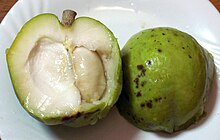| White sapote | |
|---|---|

| |
| Scientific classification | |
| Kingdom: | Plantae |
| Clade: | Tracheophytes |
| Clade: | Angiosperms |
| Clade: | Eudicots |
| Clade: | Rosids |
| Order: | Sapindales |
| Family: | Rutaceae |
| Genus: | Casimiroa |
| Species: | C. edulis |
| Binomial name | |
| Casimiroa edulis La Llave | |

The white sapote, scientific name Casimiroa edulis, also called casimiroa and Mexican apple, and known as cochitzapotl in the Nahuatl language (meaning "sleep-sapote") is a species of tropical fruiting tree in the family Rutaceae, native to eastern Mexico and Central America south to Costa Rica. The genus is named for "an Otomi Indian, Casimiro Gómez, from the town of Cardonal in Hidalgo, Mexico, who fought and died in Mexico's war of independence."
Description
Mature C. edulis trees range from 5–16 m (16–52 ft) tall and are evergreen. The leaves are alternate, palmately compound with three to five leaflets, the leaflets 6–13 cm long and 2.5–5 cm broad with an entire margin, and the leaf petiole 10–15 cm long.
The fruit is an ovoid drupe, 5–10 cm in diameter, with a thin, inedible skin turning from green to yellow when ripe, and an edible pulp, which can range in flavor from bland to banana-like to peach to pear to vanilla flan. The pulp can be creamy-white in green-skin varieties or a beige-yellow in yellow-skin varieties and has a smooth texture similar to ripe avocado. It contains from one to five large inedible seeds that are said to have narcotic properties.
Chemical constituents
In the past 40 years, experiments carried out on the white sapote's seeds have identified many pharmacologically active compounds, including: N-methylhistamine, N,N-dimethylhistamine, and histamine. It also contains 2′,5,6-trimethoxyflavone, 2′, 6',5,6,-tetramethoxyflavone (zapotin), and 5-hydroxy-2′,6,7-trimethoxyflavone (zapotinin).
Health effects
Several in vitro studies have shown that zapotin has potential anticarcinogenic effects against isolated colon cancer cells.
The fruit has long been thought to produce drowsiness, as claimed by Francisco Hernández de Toledo in the 16th century, but this may be a misinterpretation of the Nahuatl name of the plant, cochitzapotl (meaning '"sleep-sapote"), as its seeds were processed to produce a poison by the Aztecs, and the seeds and leaves, but not fruit pulp of the plant, contain sleep-inducing compounds.
Taxonomy
Unlike the mamey sapote, white sapote is a member of the family Rutaceae, to which citrus belongs. The black sapote is also unrelated and is actually a species of persimmon. This confusion may be because "sapote" comes from the Nahuatl (Aztec) word tzapotl, used to describe all soft, sweet fruit. Commonly grown in northern New South Wales, Australia, and often mistaken for a persimmon, these two fruits are unrelated.
See also
References
- "Casimiroa edulis". Germplasm Resources Information Network. Agricultural Research Service, United States Department of Agriculture. Retrieved 2009-02-06.
- "Plant Names C-F". www.calflora.net.
- photo 1
- photo 2
- photo 3
- ^ Murillo G, Hirschelman WH, Ito A, et al. (2007). "Zapotin, a phytochemical present in a Mexican fruit, prevents colon carcinogenesis". Nutrition and Cancer. 57 (1): 28–37. doi:10.1080/01635580701268097. PMID 17516860. S2CID 20080099.
- Sondheimer, F (1960). "Constituents of Casimiroa edulis Llave et Lex.—VI 2′,5,6-Trimethoxyflavone, 2′,5,6,7-tetramethoxyflavone (zapotin) and 5-hydroxy-2′,6,7-trimethoxyflavone (zapotinin)". Tetrahedron. 9 (3–4): 139–144. doi:10.1016/0040-4020(60)80001-4.
- Maiti A, Cuendet M, Kondratyuk T, Croy VL, Pezzuto JM, Cushman M (Jan 2007). "Synthesis and cancer chemopreventive activity of zapotin, a natural product from Casimiroa edulis". Journal of Medicinal Chemistry. 50 (2). American Chemical Society: 350–5. doi:10.1021/jm060915+. PMC 2523270. PMID 17228877.
- Morton, J.; Julia F. Morton (1987). "White Sapote: Casimiroa edulus Llave". Fruits of warm climates. Miami, Florida. pp. 191–196.
{{cite book}}: CS1 maint: location missing publisher (link) - Boning, Charles R. (2006). Florida's Best Fruiting Plants: Native and Exotic Trees, Shrubs, and Vines. Sarasota, Florida: Pineapple Press, Inc. p. 211. ISBN 1561643726.
Further reading
- Huxley, A. (1992). New RHS Dictionary of Gardening. Macmillan.
- Henry A. & Vera-Caletti P. 2010. – Usages du sapotier blanc (Casimiroa spp.) en Mésoamérique. Histoire, ethnographie et botanique. Anthropobotanica 1.7-2010. in French with English abstract
| Taxon identifiers | |
|---|---|
| Casimiroa edulis |
|